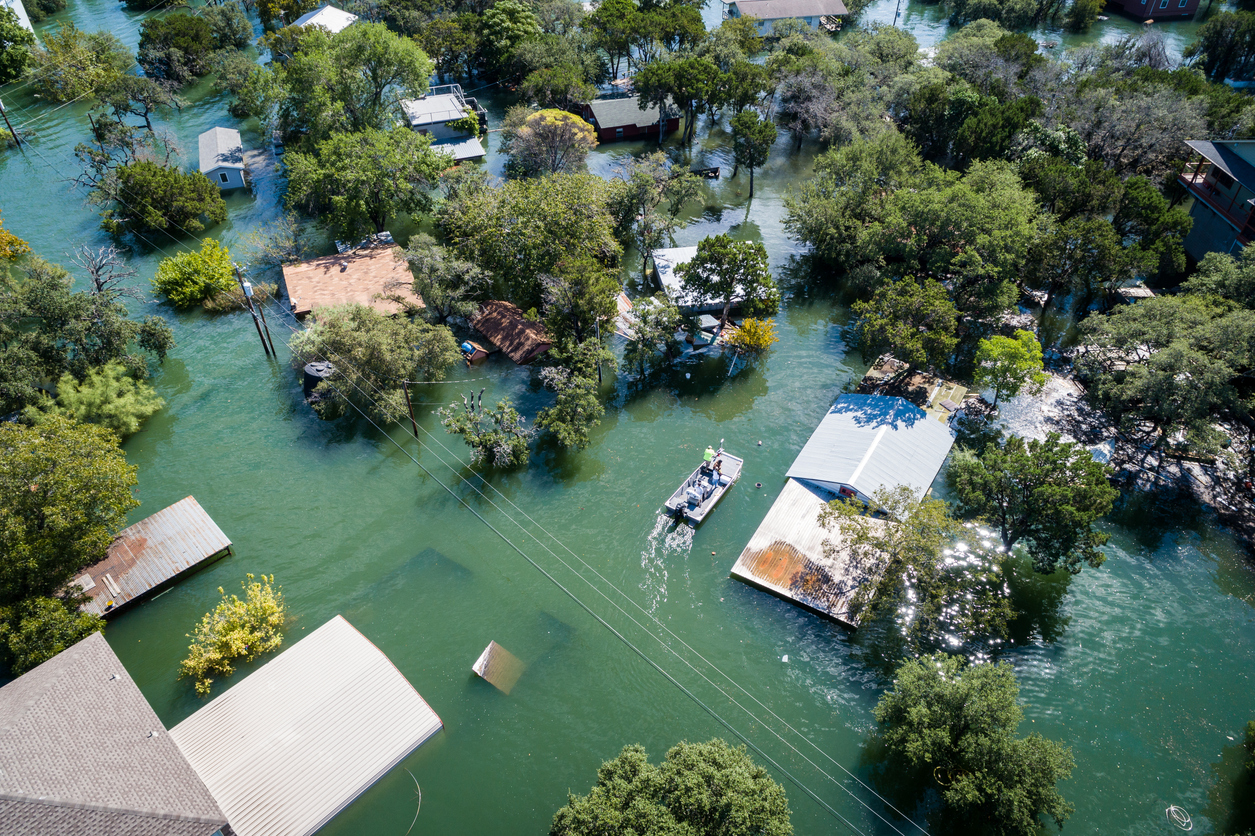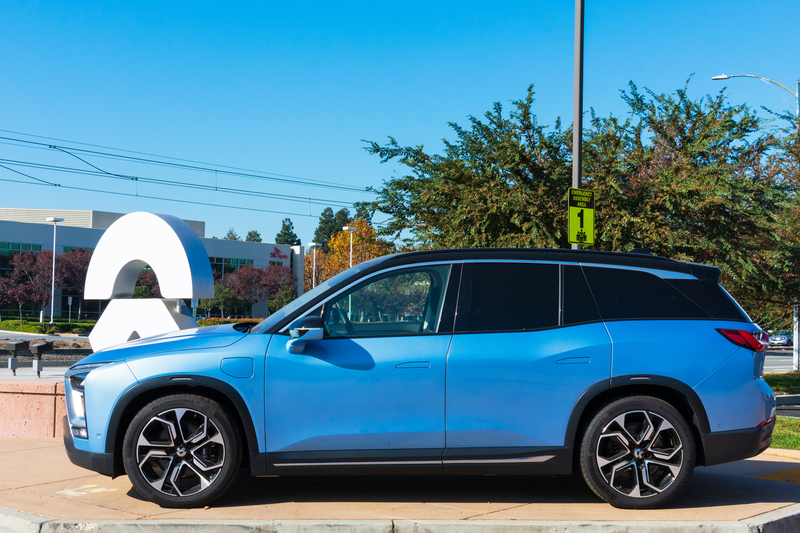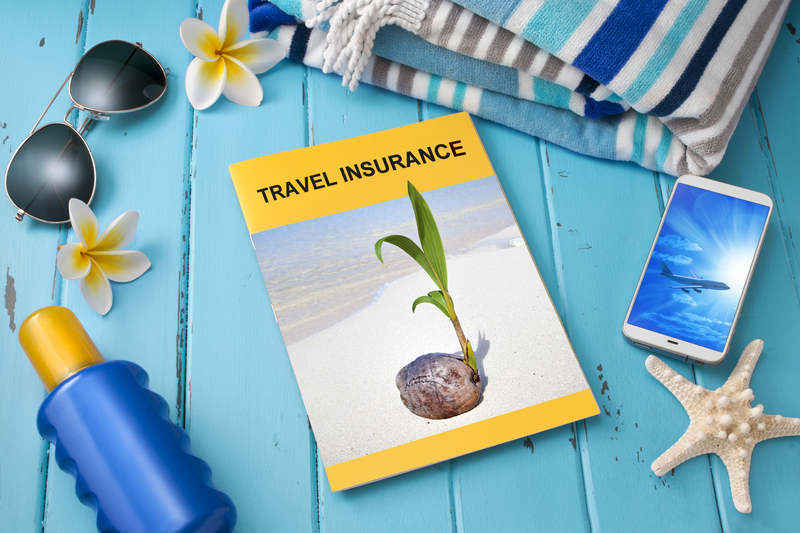Category: Auto Insurance
Preparing for a Flood Before Disaster Strikes
October 15, 2022

Flooding is the most common and most damaging natural disaster in the country. In Florida, where Hurricane Ian’s floodwaters turned towns into rivers, flood risk is higher due to the state’s frequency of storms and proximity to water. Despite this, most insurance policies do not automatically cover flooding. No matter where you live, you should check your auto and homeowner’s or renter’s insurance policies as an initial step in preparing for a flood to keep you and your loved ones safe when a flood interrupts your lives.
Determining Your Risk Level
To find out the risk level of your property location, visit FloodSmart.gov/Flood-Map-Zone.
Because research has found that FEMA’s flood maps underestimate the danger in some areas as climate change advances, homeowners and renters unaware of their level of risk should act on the following points:
- Are you in a flash-flood-prone area? Contact the local county geologist or county planning department to find out if your home is in a flash-flood-prone area or a landslide-prone area.
- Make a communication plan and a disaster plan for your family.
- Plan and practice a flood evacuation route with your family. Ask an out-of-state relative or friend to be the “family contact” in case your family is separated during a flood. Make sure everyone in your family knows the name, address, and phone number of your contact person.
- Stay informed. Learn about your community’s emergency plans, warning signals, evacuation routes, and locations of emergency shelters.
- Inform local authorities about any special needs, such as elderly or bedridden people, or anyone with a disability.
Preparing Your Home for a Flood
- Make sure you secure or protect any hazards in your home before the flood strikes.
- Be prepared to turn off electrical power when there is standing water, fallen power lines, or before you evacuate. Turn off gas and water supplies before you evacuate. Secure structurally unstable building materials.
- Buy a fire extinguisher if you don’t already have one. Make sure your family knows where it is and how to use it.
- Buy and install sump pumps with backup power.
- Have a licensed electrician raise electric components (switches, sockets, circuit breakers, and wiring) at least 12″ above your home’s projected flood elevation.
- For drains, toilets, and other sewer connections, install backflow valves or plugs to prevent floodwaters from entering.
- Anchor fuel tanks can contaminate your basement if torn free. An unanchored tank outside can be swept downstream and damage other houses.
Creating an Emergency Supply Kit
Stock your home with supplies you may need during the flood by creating an emergency supply kit. Visit the CDC’s Personal Health Preparedness page for a list of supplies you’ll want to include in your kit.
Preparing Food and Water Supplies
Make sure you and your family have enough safe food and water (for drinking, cooking, and bathing) available in the event of a flood. For more information, visit Food and Water Needs: Preparing for a Disaster or Emergency.
Reentering Your Flooded Home
When returning to a home that’s been flooded after natural disasters such as hurricanes, tornadoes, and floods, be aware that your house may be contaminated with mold or sewage, which can cause health risks for your family. See the Centers for Disease Control and Prevention’s guidelines for reentering your flooded home.
Reviewing Flood Insurance Options
Although you can purchase flood insurance at any time, waiting until a hurricane or major storm is threatening your home may be too late. Many policies take at least 30 days after purchase to take effect.
The National Flood Insurance Program is a pre-disaster flood mitigation and insurance protection program designed to reduce the escalating cost of disasters. This program makes federally backed flood insurance available to residents and business owners. Standard flood insurance by the National Flood Insurance Program generally covers physical damages directly caused by flooding within the limits of the coverage purchased. Private providers may have higher limits or broader coverage compared to National Flood Insurance Program policies.
Regardless of which policy you select for your business or family, any coverage is better than none. If your property experiences flooding impacts from a disaster, it is not guaranteed you will be able to receive federal assistance. If your area has not received a Presidential Disaster Declaration that makes federal assistance available under FEMA, you will not receive federal assistance.
When there is an official Presidential Disaster Declaration, National Flood Insurance Program policyholders are encouraged to apply for FEMA disaster assistance in addition to their flood insurance claim. For more information, visit National Flood Insurance Program or call1-800-621-FEMA.
Filing a Flood Insurance Claim
Flood insurance claims can be filed anytime you experience flooding on your property and can cover both a property and its contents.
If you need to file a flood insurance claim, be informed and prepared so that recovery can move quickly and smoothly. Before a disaster strikes, have updated photos of your home or business so that insurance providers can clearly examine your property and belongings. If your property has experienced flood impacts, take extensive photos of the damages before cleaning up. This will allow insurance providers to compare before and after photos to determine the extent of damages and arrange the best claim payment possible. As you’re cleaning, make a detailed list of lost or damaged items. If you have original receipts for items, hold onto those for documentation in your claim. After gathering all the necessary information, contact your insurance company to begin filing your claim.
InsureYouKnow.org
At InsureYouKnow.org, file your auto, and homeowner’s or renter’s insurance policies, photos before and showing flood damage, an inventory of your home and possessions, and your checklists of supplies needed for emergency events. If you are impacted by a flood, also keep track on this portal of your insurance claims and interactions with your insurance company and FEMA.
Do You Realize How “Precious” a Child Is?
September 15, 2022

The cost of raising a child through high school has risen to $310,605 because of inflation that is running close to a four-decade high, according to an estimate by the Brookings Institution, a nonprofit public policy organization based in Washington, DC.
In 2017—years before the pandemic and during an extended period of very low inflation—the U.S. Department of Agriculture (USDA) projected that the average total expenditures spent on a child from birth through age 17 would be $284,594. This estimate assumed an average inflation rate of 2.2 percent and did not include the expenses associated with sending a child to college or supporting them during their transition to adulthood. Since 2020, the inflation rate has skyrocketed— 8.5 percent as of July 2022—partly due to supply-chain issues and stimulus spending packages that put more cash into Americans’ pockets. The Federal Reserve has now raised interest rates substantially to control inflation.
The multiyear total is up $26,011, or more than 9 percent, from a calculation based on the inflation rate two years ago, before rapid price increases hit the economy, reports the Brookings Institution.
The new estimate crunches numbers for middle-income, married parents, and doesn’t include projections for single-parent households, or consider how race factors into cost challenges.
Expenses
The estimate covers a range of expenses, including housing, education, food, clothing, healthcare, and childcare, and accounts for childhood milestones and activities—baby essentials, haircuts, sports equipment, extracurricular activities, and car insurance starting in the teen years, among other costs.
In 2019, the typical expenses to raise a child were estimated by the USDA as follows:
- Housing: 29%
- Food: 18%
- Childcare and Education: 16%
- Transportation: 15%
- Healthcare: 9%
- Miscellaneous (included Personal Care and Entertainment): 7%
- Clothing: 6%
Housing
Housing at 29 percent is the most significant expense associated with raising a child. The cost and type of housing vary widely by location. Other variables include mortgage or rent payments, property tax, home repairs and maintenance, insurance, utilities, and other miscellaneous housing costs.
Food
The cost of food is the second-largest expense, at 18 percent of the overall cost of raising a child. Over time, food prices have trended up, with food-at-home pricing increasing 12.1 percent and food-away-from-home pricing increasing by 7.7 percent from June 2021 to July 2022. The USDA expects rising costs for 2022, with increases as high as 10 percent and 7.5 percent, respectively.
Childcare and Education
Childcare and education expenses in 2019 accounted for 16 percent of the cost of raising a child, and it continues to increase.
The widespread acceptance by employers of remote work and letting employees work from home part or full-time has eased the burden of childcare costs for many families, cutting the cost by as much as 30 percent for some workers.
Education is a major expense when it comes to raising children. When it comes to kindergarten through high school, parents can choose between public and private schools. For private schools, the Education Data Initiative estimated that tuition costs an average of $12,350 per year. Associated costs, like technology, textbooks, and back-to-school supplies, could bring that up to $16,050. For a child to be in private school from kindergarten through eighth grade, the estimated cost could be about $208,650. Additional expenses for extracurricular activities such as sports, the arts—music, theater, and yearbook—and other clubs also add up and are accompanied by fees for participation, equipment, and travel, which have also increased due to inflation.
Healthcare
The total cost of a health plan is set according to the number of people covered by it, as well as each person’s age and possibly their tobacco use. For example, a family of three, with two adults and a child, would pay a much higher monthly health insurance premium than an individual.
Strategies
Raising children is rewarding and fulfilling to many people. But it’s also become very expensive. By preparing mentally and implementing financial planning strategies, you can be well-equipped to raise your child to adulthood comfortably, even on a budget.
InsureYouKnow.org
If you are a parent, you are responsible for raising your child and providing food, clothing, shelter, and security. Consider getting insurance coverage—including life, short- and long-term disability, and health insurance to avoid putting your family at risk financially in the event of unexpected hardship. To cope with the rising costs of raising children, live within your means, save money wherever possible, and shop around for home and auto insurance each year for the best deals. At insureyouknow.org, you can track your expenses to raise a child and file insurance policies that cover your family’s financial and healthcare needs.
Before You Step on the Gas, Plan Your Travel Strategy
June 11, 2022

The pros and cons of planning a summer road trip this year have gotten more complicated as rising gas prices threaten to make a bigger dent in your travel budget.
The national average for gasoline could be close to $6 by later this summer according to Tom Kloza, global head of energy analysis for the OPIS, which tracks gas prices for AAA.
To cut your gas costs, consider using the following tips to get more miles per gallon as you embark on the summer excursion you’ve been dreaming about all year.
Slow down.
Each 5 mph you drive over 60 mph is like paying an additional $0.15 per gallon for gas. Aggressive driving—speeding, rapid acceleration, and braking—wastes gas. Eliminate these practices and you may save $.12-$.82 per gallon for gas.
Keep your car maintained and running smoothly.
Make sure you have your car maintained before you hit the road by getting a tune up and clean air filters, inflating your tires properly, and using the proper grade of oil. Don’t fill up with premium gas if your car doesn’t require it. Before you drive, make sure your tires aren’t under-inflated. If they are, you will likely burn more fuel per mile than when your tires are correctly inflated.
Use your engine wisely.
Avoid excessive idling and use cruise control and overdrive gears.
Be smart about driving.
Plan errands to do them together, rather than on separate trips; carpool, walk, or cycle; use public transportation; and telecommute. If you’re in the market for a new car, consider buying a more energy-efficient or a smaller car.
Keep your car light.
Don’t store unnecessary items that add weight to your car. When you place cargo on the car’s roof, avoid excess weight that will put a strain on your engine and affect your fuel mileage.
Use apps to find the cheapest gas prices near you.
Stay updated on gas prices by using apps and sites like Gasbuddy.com, Waze, , AAA, and GasGuru. They help check gas prices in your location, so you can find pumps where you can save the most money.
Pay cash or use a cash back credit card.
You may be able to save about $.10 per gallon if you pay with cash at the pump. If you don’t want to deal with cash, consider opting for a cash back credit card for gas expenses.
Utilize fuel rewards programs.
Find convenience and grocery stores with gas fueling stations that offer rewards programs for a percentage off gas fill-ups based on total amounts you spend shopping in the stores.
Look forward to the future.
Although current fuel rates may take a big bite out of your travel budget this summer, trust—as in past years of 2008, 2012, and even the early 1980s—gas prices will eventually bounce back. Wisely use the gas-saving tips mentioned above to ease your way through the current high gas prices.
InsureYouKnow.org
When you travel this summer, keep records of your auto insurance, car maintenance, travel insurance, and rental car and hotel expenses at insureyouknow.org. You’ll be able to refer to these documents while you’re on the road and after you return home when you reflect on your wonderful summer vacation.
College Graduates’ Guide to Insurance
May 31, 2022

Congratulations to college graduates everywhere as the graduation season kicks off in 2022! Homework continues, however, as grads meet the challenges presented by their next decisions—changing their residences, jobs, and insurance coverages. Even though this last item may not be as exciting as finding a new place to live or pursuing a lucrative career opportunity, the following options in insurance coverages are important issues that new college grads need to address.
Health Insurance
Since the passage of the Affordable Care Act (ACA), choosing new coverage—or holding on to existing coverage—has been much easier for college graduates who may decide to:
1. Remain on a parent’s insurance plan
Before the ACA was enacted, it was common for health insurance plans to drop dependents as soon as they graduated from college. But the ACA requires almost all health plans that offer dependent coverage to allow young adults to remain on a parent’s plan until they turn 26. So, for young adults covered under a parent’s plan, graduating from college no longer requires them to quickly find new health insurance.
2. Purchase a short-term plan
Short-term health insurance is a potential alternative for college grads who need temporary coverage to tide them over until another policy kicks in. Even for grads who have a job lined up right away, employers often have a waiting period before health insurance coverage is available to new hires. Short-term plans can be purchased at any time of the year, with immediate effective dates available.
3. Buy an ACA-compliant individual plan
For new grads who want a more robust, ACA-compliant plan that covers the essential health benefits and pre-existing conditions, a plan purchased through the state health insurance exchange is likely to be an ideal solution. For more information about marketplace insurance, visit www.healthcare.gov.
4. Check Medicaid eligibility
In 38 states, Medicaid has been expanded to cover all adults with income up to 138 percent of the poverty level. In 2022, that’s $18,754 for a single individual, except in Alaska and Hawaii where the limit is higher. Medicaid enrollment is available year-round and coverage includes pre-existing conditions. In most cases, there are no premiums. For a new grad living in a state where Medicaid has been expanded, this could be a perfect solution during the weeks or months that it might take to find a job after graduation.
5. Get coverage through a new employer
College grads may be able to enroll in group coverage at their new jobs. Employer-sponsored health insurance generally offers substantial benefits, and employers typically pay a large portion of the premiums. Employee contributions are paid through payroll deductions. Participants also may be eligible to enroll in a Health Savings Account that minimizes the financial impact of out-of-pocket medical expenses.
Renters’ and Homeowners’ Insurance Policies
Before graduation, college students probably lived in a dorm room or shared housing with other students. Now, it may be time for them to relocate to their first apartment, condo, or house.
Renters need to understand that their landlord’s insurance doesn’t cover their belongings. Suppose renters experience an unforeseen situation, including burglary, stormy weather that causes a leaky roof to destroy their furnishings, or a fire that creates smoke damage. In these scenarios, they could be protected by renters’ insurance.
Homeowners’ insurance policies, available to college grads buying their first condos or houses, combine several types of coverage, including dwelling, personal property, other structures, loss of use, personal liability, and medical payments into one policy,
It’s a good idea for renters and homebuyers to create a spreadsheet with an inventory of the contents of their residences, placing approximate values on their belongings.
Auto Insurance
Upon completing college, grads may be ready to buy a new car that requires upgrading their auto insurance, especially if they had been previously covered under their parents’ policy. Personal auto insurance is a package policy providing four coverages—liability, medical payments, uninsured and underinsured motorist, and physical damage.
Life Insurance
Unless a college grad is married or has individuals, such as a child or an aging parent dependent on their income, life insurance may not be needed right away. However, if young adults are single, healthy, and in a family with a good health history, they may be at an insurability peak and would benefit from the best rates on life insurance.
InsureYouKnow.org
College graduation prompts a transition from a school-based existence to one replete with adult responsibilities, including the need to put insurance policies in place. By preparing for the unforeseen future, college grads who do their homework on insurance options and keep copies of policies, inventories of their belongings, and records of any claims submitted at insureyouknow.org, can begin living their lives to the fullest.
Resolve to Go Paperless in 2022
December 30, 2021

In January, follow the example of the U.S. government that has committed to moving to a paperless archival system by December 31, 2022. The Office of Management and Budget’s (OMB) directive for government agencies to transition to electronic records has prompted them to take steps in their modernization journeys.
The government faces multiple challenges with paper records, such as burdens on the workforce and high costs to manually create, use, and store nonelectronic information. As an individual, you may face similar dilemmas in dealing at home with your printed files, insurance records, and other important documents that would be difficult to replace if damaged or destroyed by natural disasters or accidents.
As government agencies transition to electronic records, many are experimenting with new technologies to sort through electronically stored information. Universities and businesses also have guidelines for storing electronic records in online repositories that they strive to:
- Back up regularly
- Comply with all privacy and security requirements
- Allow for shared access through a network or a cloud-based program
- Organize in such a way that records can be identified and purged appropriately
- Set up to migrate content to a new system upon replacement
- Maintain through regular software updates
InsureYouKnow.org
After you review the electronic storage practices of the government, universities, and businesses, establish your own ground rules for storing your important records at InsureYouKnow.org. Keep in mind the following tips:
- A systematic plan for keeping track of important documents can save you hours of anxious searching for misplaced items. It also can help you reduce the number of nonimportant papers cluttering your home.
- It is important to carefully store valuable papers which would be difficult or time-consuming to replace. Original hard-to-replace documents are ideally kept in a safe deposit box or a fire-proof, waterproof, burglar-proof home safe or lockbox. Scanned copies can be stored at InsureYouKnow.org where they will be readily accessible.
- Electronically stored records must be legible, readable, and accessible for the period of limitations required. It is important to back up electronic files at InsureYouKnow.org in case of a computer malfunction in your home office.
- Wherever you live, there is always a risk of fires, floods, and other disasters, and your home and important documents could be destroyed. If you have stored photographic images, you’ll have records accessible whenever you need them, including keeping peace of mind knowing documents are indestructible at InsureYouKnow.org.
Valuable papers can be sorted into two types: those needed for day-to-day use and those needed occasionally.
Examples of valuable papers used frequently include:
- Drivers’ licenses
- Credit cards
- Health insurance cards
- Bank account records
- Identification cards
- Special health documentation such as COVID-19 vaccinations, allergies, disabling conditions, prescriptions, and blood types for family members
Examples of valuable papers used occasionally include:
- Birth, marriage, and death certificates
- Deeds, leases, and property records and titles
- Income and employment records
- Passports
- Contracts
- Insurance policies
- Income tax records
- Military papers
- Divorce decrees
- Social Security records
- Retirement and pension plans
- Wills
Regular filing and reviewing of paper and electronic documents are important. Making decisions on when to discard old, printed files and purge electronic versions may be difficult but worth the effort to keep accurate, up-to-date records.
Get Ready, Get Set, Go Electric!
July 13, 2021

Electric vehicles (EVs) are becoming more popular, practical, and affordable, but they aren’t new additions to the transportation industry. The first electric car was invented in 1832 by Robert Anderson and this mode of travel became popular beginning in 1889 when William Morrison made the first successful EV in the United States. Originally, EVs could only travel up to 100 miles on a single charge and were more expensive to purchase than vehicles that relied on combustible engines.
Mass production of EVs as we now know them started in the 1990s. During the past few years, EVs have experienced a rise in popularity as battery-powered technology has progressed and costs have declined. Climate and environmental awareness have prompted support for clean transportation, increased charging opportunities, and EV adoption.
In the United States, the Biden administration has pledged to cut the pollution driving global warming by 50 percent from 2005 levels by 2030. If you are committed to this goal that requires a radical transformation of the nation’s economy away from fossil fuels, you may want to consider the costs, insurance coverage, and benefits associated with owning an EV with zero emissions.
Costs and Incentives
Powered by a battery pack, EVs are in demand because of their quieter, simpler, and less-polluting driving experience. According to Car and Driver, “Basic electric models start at around $30,000 with luxury model prices climbing to $80,000 and more. Usually, a car buyer will pay at least $10,000 more for an electric car than they would for the same type of car in a gas model. As technology continues to evolve, this price gap is likely to close.”
Some models can travel more than 370 miles with a single charge. Installing a home charging station costs between $200 and $1,000 and allows you to charge your vehicle at home. You can find locations of public charging stations and associated fees at Plugshare.com.
You may be eligible for rebates or incentives offered by utility companies. For example, the California Clean Vehicle Rebate Project pays rebates up to $4,500 to Californians who purchase an eligible electric battery vehicle. The federal government offers tax credits up to $7,500 for purchasing certain makes and models of electric cars and SUVs.
Insurance
Electric vehicle owners may face higher insurance rates, but owning an EV becomes more affordable all the time. If you shop around, you may be able to find car insurance rates comparable to insuring conventional cars.
Follow these steps to save additional money on insuring your EV:
- File your claims wisely. Car insurance companies may raise your rates once you file a claim. These claims stay active on your account for three years, but the rate increase varies by state.
- Look for discounts. Ask your current licensed insurance company if there are discounts not presently covered on your policy. Examples may include discount programs for EVs, multiple policies to insure more than one vehicle, remaining claims-free, taking a defensive driving course, using alternative fuel, or paying your premium in full.
- Compare insurance rates. Compare rates from several companies to make sure you’re getting the best price to insure your EV.
- Find companies that reward you. Certain insurance companies offer discounts specifically for people who drive EVs. The amount depends on the company, but premium reductions typically are about 5 percent for a six-month policy.
Benefits
Over the past decade, the popularity of EVs has spiked. Many consumers buy them to save money at the gas station, while others want to help the environment. Some of the more appreciated reasons to switch to an EV include:
- Energy independence
- Reduced environmental impact
- Lower inhaled emissions
- Reduced maintenance expenses
- Reduction of fuel expenses
- Extended battery life
- Quieter driving experience
- Availability of highway lanes dedicated to EVs
InsureYouKnow.org
When you’re ready to buy an EV, your due diligence should include comparative shopping for your ideal vehicle and insurance coverage to meet your commitment to a cleaner environment and your future driving adventures. After you’ve made your decisions, keep track of your EV purchase, insurance, driving log, and maintenance expenses at InsureYouKnow.org.
Have Insurance, Will Travel
June 15, 2021

You’ve done your planning, scheduled time off, and made reservations for a well-deserved vacation. But what if something unforeseen happens–like lost luggage, flight delays, or a medical emergency–to upend the time away you had envisioned? You may want to add to your pre-trip checklist travel insurance, a type of policy that reimburses you for money you lose from non-refundable deposits and payments when something goes wrong on your trip.
A general rule to consider is that the more you’re spending on your trip, the more likely you’ll need travel insurance. Costs for international trips and cruises can add up quickly and being away from a safety net at home can be fraught with problems. But don’t hastily sign up for travel insurance and neglect to understand what is and isn’t covered by the plan you are considering. Do some comparison shopping for travel insurance and look for options that match your needs.
Policy Benefits to Consider
- Cancellation allowed for any reason
- Emergency medical expenses, including coverage for COVID-19 and dental care
- Emergency medical evacuation
- Trip cancellation reimbursement
- Ability to review a purchased policy and to reconsider enrollment without penalty
- Reimbursement for lost baggage
- Compensation for missed connection, travel delay, trip interruption or cancellation due to injuries, weather, hurricanes, or terrorism
- Coverage for lost or stolen passports
Mistakes to Avoid
- Skipping travel insurance
- Failing to find a plan that covers COVID-19 or another coronavirus outbreak
- Ignoring the limits of your coverage and not reading your policy thoroughly
- Not understanding “cancel for any reason” coverage
- A “cancel for any reason” policy must be purchased within 7 to 21 days of making the initial trip deposit. Also, you must cancel the trip no later than 48 hours before departure to get reimbursement under “cancel for any reason” coverage. Also, travelers may think they’ll get all their money back. But “cancel for any reason” coverage only provides 50% to 75% of your out-of-pocket expenses, depending on the level you choose. Don’t set yourself up for disappointment if you cancel your trip at the last minute and you can recover only half of your loss.
- Waiting until the last minute to secure travel insurance
- Buying travel insurance from an unreliable source
Limits to Think About
- Pre-existing medical conditions that may worsen during your trip aren’t covered unless you purchase a pre-existing conditions exclusion waiver.
- High-risk activities may not be covered, such as scuba diving; nor are problems that happen because you are intoxicated or are using drugs.
- Medical tourism is also a common exclusion, so if you’re going abroad for a face lift, travel insurance won’t cover hospital bills or aftercare.
Reasons to Buy Travel Insurance
Two major factors should influence your decision to buy travel insurance:
- Financial Risk: Are you worried about losing money because of a canceled, delayed, or interrupted trip, lost luggage, or a medical emergency?
- Medical Concerns: Are you traveling outside your home country where your insurance from home won’t cover you for an accident or illness?
Reasons Not to Buy Travel Insurance
- Last minute domestic trips
- Cheap domestic trips
- You can afford to lose your prepaid trip expenses
Resources to Buy Travel Insurance
At NerdWallet.com, Forbes.com, and TravelInsurance.com, you can find comparison data on travel insurance carriers and policies. By using these resources, you’ll be able to enroll in a plan suited for your needs when you’re ready to travel.
InsureYouKnow.org
At InsureYouKnow.org, you can file copies of your travel insurance policies, driver’s license, auto insurance policy, passport, health insurance cards, vaccine passport, and the credit cards you plan to take with you. If your physical credentials are lost or stolen while traveling, you can access recorded information online that you’ll need to prove your coverage or to start the process of obtaining new documents.
Safely Enjoy Summer Fun in the Sun
May 29, 2021

With students out of school and parents ready for a vacation, your summer planning may lead to seasonal activities and events outside during the warmest time of the year. While making a list of your fun in the sun options, keep in mind your family’s health and safety while avoiding the dangers of heat-related illnesses, water-related injuries, grilling hazards and food poisoning, allergy attacks, and the stress of traveling.
The Federal Occupational Health agency offers the following tips for balancing fun activities and sun safety.
Prepare for Heat and Sun
A big part of staying safe in the heat and sun is being prepared. Have an idea of how long you will be out in the sun and the heat, and then plan accordingly by:
- Limiting your outdoor activity, especially midday when the sun is hottest.
- Wearing and reapplying sunscreen as indicated on the package.
- Pacing your activity; starting activities slowly and picking up the pace gradually.
- Drinking more water than usual and not waiting until you’re thirsty to drink more.
- Wearing loose, lightweight, light-colored clothing that protects your skin.
- Wearing sunglasses and a hat.
- If possible, taking breaks from the heat and sun in a shady or air-conditioned location.
For more information, visit the Centers for Disease Control and Prevention’s (CDC) Keep Your Cool in Hot Weather! and Sun Safety pages.
Stay Hydrated
Dehydration is a safety concern, especially during the summer months. Be sure to drink enough liquids throughout the day, as your body can lose a lot of water through perspiration when it gets hot outside. Drinking plenty of water can be part of good nutrition, too. Snacking on water-rich foods like raw fruits and vegetables also can help keep you hydrated.
Without enough fluids, you may experience dehydration. Look for these signs:
- Extreme thirst
- Dry mouth
- Headache
- Muscle cramping
- Feeling lightheaded
- Foggy thinking
Learn more on the MedlinePlus Dehydration page.
Heed Water Safety Precautions
Swimming is an enjoyable way to both cool off and get some exercise, but it also takes extra precautions and vigilance. To lower the risk for water-related injuries or accidents:
- Always have adult supervision for children who are in or around water.
- Do not swim alone, and swim near lifeguards whenever possible.
- Learn to swim.
- If you have difficulty swimming, wear a life jacket when participating in water-related activities.
- Wear a life jacket when boating.
- Know local weather conditions and forecasts before swimming or boating.
For more information, visit CDC’s Water-Related Injuries page.
Additional summer safety reminders include the following tips from National Insurance Services:
Eliminate Grilling Risks
Grilling is a great way to make a delicious meal, especially during summer get-togethers and events. However, grilling carries a number of risks—from fire to food poisoning—that you must be aware of to keep your outing safe and enjoyable. Experts say that food poisoning peaks in summer months for two main reasons: bacteria grow fastest in warm, humid weather, and people generally do not pay as much attention to cleanliness when eating outside.
General Safety Precautions
- Do not allow children and pets to play near the grill until it is completely cool, and you’ve had a chance to put it away.
- Place your grill at least 3 feet away from other objects, including your house, vehicle, trees, and outdoor seating.
- Before using a gas grill, check the connection between the propane tank and the fuel line to make sure it is not leaking and is working properly.
- Only use starter fluid for barbecue grills that use charcoal. Do not use starter fluid for gas grills.
- If you suspect that your gas grill is leaking, turn off the gas and get the unit repaired before lighting it again.
- Never use a match to check for leaks.
- Do not bring your grill into an unventilated or enclosed space, such as a garage or inside your home. This is not only a major fire hazard, but it’s also a carbon monoxide hazard.
- Never grill on wooden decks, porches, or balconies.
Carcinogen Hazard Preventions
- Cook leaner meats that drip less grease. Opt for a turkey burger or a lean cut of beef, and cut visible fat from poultry. When fat drips into the coals or flames, smoke travels up to the meat and releases carcinogens.
- Marinate meat to reduce carcinogens by 87 percent. Herbs contain polyphenolic antioxidants, which prevent the formation of carcinogens on the meat’s surface.
- Scrub your grill with a wire brush after every use. This will prevent bits of leftover food from dropping into the grate and creating carcinogen-filled smoke.
- Use a nonstick cooking spray on the grill rack to prevent meat buildup.
Follow Food Safety Tips
- Wash your hands. You should do this before all types of food prep, and grilling is no exception. If you’re outdoors and there is no bathroom, use a water jug, some soap, and paper towels. Consider carrying moist towelettes for cleaning your hands.
- Separate raw and cooked food. Don’t use a plate or utensil that previously touched raw food to touch cooked food unless the utensil has been washed with hot, soapy water.
- Marinate your food in the refrigerator, not on the counter.
- Make sure food is cooked thoroughly to kill any harmful bacteria that may be present. Hamburgers should be cooked to 160 degrees Fahrenheit, or until they are brown all the way through. Chicken should be cooked to 165 degrees Fahrenheit.
- Refrigerate leftovers within two hours of being cooked—the sooner, the better.
Manage Allergies
Warm weather and high humidity can put a strain on seasonal allergy and asthma sufferers. It’s a peak time for certain types of pollen, smog, and mold. Below are some survival tips to help you manage your allergies during the summer months.
- Protect yourself during prime allergy time—stay indoors between 5 a.m. and 10 a.m., when outdoor pollen counts are usually the highest.
- Avoid extremes—going between intense outdoor heat and indoor air conditioning can trigger an asthma attack and other allergy symptoms.
- Wear a mask when mowing the lawn or if you know you are going to be around freshly cut grass. Also, take a shower, wash your hair, and change your clothes to remove any pollen that may have collected on your body. You should also dry clothing inside, rather than on an outside line.
- Patrol your yard for weeds such as nettle or ragweed and oak, birch, cedar, and cottonwood trees—they all can trigger allergies.
- If you’re allergic to bees, protect yourself. Wear shoes, long pants, and sleeves. It’s also a good idea not to wear scented deodorants, hair products or perfumes, as all of these can attract bees.
Travel Safely this Summer
The following tips can help you plan for a safe and fun road trip:
- Buckle up for safety; you’ll avoid a ticket, and more importantly, should you get into an accident, you’ll increase the odds of surviving the crash and reducing injuries for both you and your family.
- Get a good night’s sleep; drowsy drivers can be as dangerous behind the wheel as drunk drivers. And don’t think coffee or opening windows will be enough to keep you awake— there is no substitute for a good night’s sleep.
- Take a break from driving if you feel yourself getting drowsy. Get out of the car for some exercise or switch drivers if you have that option.
- Do not drink alcohol and drive—you put yourself and anyone around you in danger.
- Conduct a pre-road trip inspection on your vehicle—taking just 10 minutes to ensure your car’s tires are properly inflated, that the fluids are topped off, and that everything under the hood is all right—to identify and mitigate problems that could lead to future breakdowns.
Review CDC’s travel tips on the following topics that are continuously updated as needed:
- Domestic Travel During COVID-19
- When NOT to Travel: Avoid Spreading COVID-19
- Safer Travel Tips for Families with Unvaccinated Children
- Requirement for Face Masks on Public Transportation Conveyances and at Transportation Hubs
- Travel Health Notices
- Cruise Ship Travel
- International Travel During COVID-19
- Travel Recommendations by Destination
- After International Travel
- Travel Planner
- Travelers Returning from Cruise Ship and River Cruise Voyages
- Travel: Frequently Asked Questions and Answers
- Travelers Prohibited from Entry to the United States
- Communication Resources for Travelers
InsureYouKnow.org
When planning your summer vacations, keep track at insureyouknow.org of your health, automobile, boat, and travel insurance policies, as well as passports and COVID-19 vaccination records, for you and your family members. In case you face an emergency or need to prove your coverage, you’ll be able to refer to your secure documents online.
Driving (or Not) with Auto Insurance
February 15, 2021

Although you may not be driving as much during the COVID-19 pandemic as you did in previous years, you still need to have auto insurance if you own a vehicle. The following tips may help you establish or review your auto insurance policy as you dream about taking road trips while your motionless car is parked in your driveway.
Visit Your Auto Insurer Online
Before the pandemic, you may have felt comfortable visiting your auto insurer’s office to apply for or review your auto insurance policy, or to file a claim for a car accident, vandalism, car theft, hail, fire, floods, falling objects, and collisions with animals. During the COVID-19 pandemic, however, claims are processed virtually. You can use your insurer’s mobile app or website and go through the entire claims process from the comfort of your own home.
In the event of an accident, you may be able to upload photos of your car’s damage that your insurer can use to estimate a repair and then send you a payment quickly.
Get Insurance Before You Buy a Car
Shop for car insurance before you buy a car so you can drive your new car off the dealer’s lot. There are four basic kinds of car insurance coverage: property damage liability, bodily injury liability, collision, and comprehensive. Review each one of these types of coverages carefully and decide which ones fit your needs. You might also want to consider getting protection in the event of an accident caused by an uninsured or underinsured driver.
You’re going to need proof of insurance when you buy a car before you can take it home with you. Follow these steps to get insurance:
- Have a make, model, and year in mind. In the process of car shopping, you’ve most likely identified the types of cars you’re interested in buying. An insurance agent can give you quotations for a few models, so you can budget accordingly.
- Compare quotations from multiple car insurance companies. An independent insurance agent or online car insurance comparison site is an efficient way to price shop. Rates vary considerably among insurers, so you will want more than one or two quotations.
- Understand what coverage types you’ll need. Most states require you to carry car liability insurance. Also, if you’re taking out a car loan or lease, your lender or leasing agent will most likely require collision and comprehensive insurance.
- Ask your insurance agent to set up a policy. If you have the car picked out and know the vehicle identification number (VIN), you can have your policy ready to go before you arrive at the dealership. If you don’t have the VIN yet, ask if the agent can set up a policy with the information you have, like the drivers in your household and the address where you’ll keep the vehicle. Once you decide on the car, call the agent with the VIN to complete the purchase of the car insurance policy.
- Ask about bundling. Some insurance companies offer discounts to protect all your property with one insurer. Multiple-policy discounts can apply to combinations of home, auto, and life, and even motorcycle insurance.
Look into Pay-Per-Mile Insurance
If the pandemic has drastically altered your driving behavior since you aren’t commuting to work or going on road trips, you might want to look into an alternative car insurance model like pay-per-mile insurance.
In this plan, you’ll get charged a base rate per month plus a per-mile rate. Your monthly bill will depend on how much you drive. For example, if you drive 600 miles in a month at a $29 base rate and a $0.05 per-mile rate, your bill for that month would be $59. But, if you do return to commuting to your office you could end up paying more per month than with a traditional car insurance policy.
Reconsider Dropping Optional Coverage
If you have an older car and you’re considering dropping collision and comprehensive insurance to save on your insurance policy, Forbes Advisor recommends that you reconsider. Dropping coverage could leave you with a significant coverage gap. But you don’t have to drop both. It may be better financially to drop collision insurance but keep comprehensive insurance, which pays for repairs, such as ones caused by hail or falling tree branches that don’t involve your own driving.
Check on Auto Policy for Delivery Job
If you’ve taken on a delivery job and use your car for deliveries from a restaurant, grocery store, or other business, check with your car insurer to see if you need a commercial auto policy. If you’re involved in an accident while working, your personal auto policy may not cover your claim and you could be held responsible for repair bills and medical expenses.
Cover Your Teenage Driver
If you have a teen who’s driving, you’re going to pay a premium rate for his car insurance. Adding an inexperienced teen driver to your insurance will add an average of about $1,700 annually to your car insurance bill, based on Forbes Advisor’s research.
But there are ways to reduce anxiety about teen driving. By being a good driver role model, you can spend time driving with your teen and instill safe driving habits, including not using a phone while driving. If your teenager keeps accidents and violations off his driving record, the result will be substantially cheaper rates.
Protect Senior Driver’s Rates
If you are a senior driver with a perfect driving record, with no accidents or claims, you might wonder why your car insurance rates have increased. You might be in excellent health for someone your age and you might feel that your insurer is discriminating based on how old you are. However, insurance companies are legally allowed to charge any premium they want based on your driving record or age. Even if your reflexes are sharper than many other drivers of your age or drivers who are younger, your insurer will place you in the senior driver’s category along with other senior drivers whose reflexes are not as sharp as yours.
The following methods can help senior drivers save money on car insurance:
- Change your driving status. If you are retired, then changing your driving status to pleasure or leisure can help you save money. This status covers all of your daily routines that are non-work related. Drivers who are placed in this category will be seen as a lower-risk by their insurers and they will pay less on their insurance rates.
- Ask for a senior discount. Many insurance companies offer a discount to seniors who take a defensive driving course. These courses are not expensive and you can can stream them online at home. They can help you refresh your driving skills and knowledge and teach you how age-related diseases and medication can affect driving.
- Drop a driver from your policy. There are some states where not all the licensed drivers from a household are required to have car insurance. In order to reduce your policy rates, you can exclude anyone from your policy who no longer drives. Usually, those persons are older spouses or parents. Also, you can change the primary driver from your policy to someone from the household who is younger, but only if that person is the one who is driving the most.
- Improve your car’s safety. Another method used by drivers of any age to save on car insurance is to install safety devices on the vehicle. You can lower your premiums if you install safety systems like rearview cameras, lane drift, parking assist, and collision warning systems.
- Shop around. Maybe the best option you can have to lower your insurance rates is to shop around and compare different car insurance quotations. Insurance companies have different premiums for different groups of people. Compare insurance quotations to find an insurance rate and coverage to your advantage.
InsureYouKnow.org
At InsureYouKnow.org, file copies of your proof of insurance, policy documents, and any car insurance claims or correspondence you file with your auto insurance carrier.
2021 Benefits for a Happy, Healthy, and Productive Workforce
December 30, 2020

According to a study by the Stanford Institute for Economic Policy Research, 42 percent of the U.S. workforce worked from home in 2020. New challenges for a stay-at-home workforce include balancing work while caring for children or the elderly, dealing with mental health and other medical issues, and having opportunities for options in their work schedules. In response to these issues, some proactive businesses plan to provide child-care enhancements, telehealth benefits, and other flexible opportunities in 2021 to keep employees happy, healthy, and productive.
Child Care Benefits
For working parents, COVID-19 has been a balancing act of work and home responsibilities. At the beginning of the pandemic, 60 percent of parents had no child care support and they currently spend, on average, 52 hours per week on child care, homeschooling, and other household tasks according to a Boston Consulting Group survey.
One of the most innovative trends of 2021 will be to offer expanded support for child care. Some employers will boost child care benefits to include tutoring services, emergency child care support, virtual support groups for parents, onsite day care in the workplace, in-home child care for work-at-home employees, and virtual activities to keep kids occupied. These supportive measures will help alleviate stress at home so parents can be more focused and productive at work.
Mental Health Support
During the COVID-19 pandemic, many employees struggling with mental health challenges seek support from employers to cope with stress, anxiety, and burnout. Employers can offer telehealth resources and other virtual health tools like meditation apps, access to professional therapy, sleep tools, resilience training, and one-on-one behavioral coaching.
In a recent survey of employers by the Business Group on Health, two-thirds of businesses said they offer online mental health support and that is expected to grow to 88 percent in 2021. The stress of the pandemic combined with increased access to telemedicine will result in expansion of mental health benefits. Patients who are uncomfortable seeking help for stress and anxiety in person may experience less apprehension in a telemedicine environment.
Most employers also are providing increased access to other online mental health support resources such as apps, videos, and additional on-demand information. Still others are implementing manager training to help supervisory staff recognize mental and behavioral health issues and direct employees to appropriate services.
Telehealth Benefits
Since the pandemic began, an unprecedented number of people have scheduled virtual medical appointments, fearing potential exposure to the coronavirus. As telehealth availability increased in 2020, more patients began opting for this type of care. Even those not worried about contact with COVID-19 have appreciated the convenience of not missing a day of work to spend hours going to a doctor’s office in person.
Telehealth options have been expanding for years with both healthcare providers and health insurance carriers offering consumers the option to seek non-emergency care for minor illnesses from the comfort of their own homes or offices.
Additional telehealth alternatives will likely be added to many employee health plans as a way to address concerns over direct contact during the COVID-19 pandemic and because of the overall convenience of virtual visits.
Improved In-office Benefits
During the pandemic, patients who have gone into a doctor’s office have been met with thermometers, sanitizers, fewer fellow patients in waiting rooms, and shorter waiting times. Consumers will continue to demand in 2021 a streamlined in-office experience without a loss of efficiency in the administration of healthcare.
Flexible PTO and Sick Leave
The COVID-19 pandemic has redefined
the workplace and employers’ leave policies to expand paid time off (PTO) and to
provide more flexibility around work hours.
The Families First Coronavirus Response Act, passed in March 2020, ensured all
employees receive two weeks of paid sick leave to care for themselves or loved ones.
Taking time off includes not only
going on a vacation but also allows for leave for family and caregiver roles to
achieve a good work-life balance that helps employees be productive at work and
more present in their personal lives. With many employees having no place to go
for an extended vacation, employers are also changing PTO policies out of
concern employees won’t use allotted paid time off during the pandemic.
Some employers are allowing employees to carry over a portion of unused PTO
into 2021, while others are experimenting with PTO sharing programs, so employees
can donate their vacation time to a charity, a general company fund, or a
specific colleague.
A combination of adjusting time off policies, offering more flexible work schedules, or adopting new policies in general are some of the ways employers will address these concerns in 2021.
Financial Wellness
As the pandemic sent shockwaves through the U.S. labor market with layoffs, pay cuts and furloughs, employers made sure to support employees through financial challenges with benefits like early wage access, automated savings programs, and education resources.
Many employers provide optional benefits like additional life or disability insurance as well as offering employees resources and education to reduce stress and enhance financial well-being. Some programs include educational sessions on common topics like reducing debt, while others include complimentary meetings with financial advisors. A few companies have opted to solve their PTO dilemma and financial stress by allowing employees to directly apply a PTO payout to student loan debt.
Health and Fitness Options
The transition to remote work means employees may be more sedentary than in an office building. To help employees alleviate stress and stay physically active, new virtual fitness offerings have become a must-have employee benefit during the COVID-19 pandemic.
Countless employers are taking
their wellness programs online, offering virtual yoga, kickboxing, Tae Kwon Do,
and other types of fitness classes. Wellness contests such as virtual fun runs,
walks, and biking competitions also have been popular.
Some employers have hosted virtual lunch and learning programs, as well as online
happy hours, and collaborative movie viewing. Many have introduced online
gaming sessions, which have included trivia contests, Zoom bingo, and
competitions for best virtual backgrounds. Still others are relying on old-fashioned but Zoom-friendly games such as Scattergories, Pictionary, Charades, and
Heads-up.
Expansion of Other Benefits
Many employers will continue to make their benefits plans more attractive by increasing the availability of additional voluntary benefits such as life and disability insurance, home, auto, and pet insurance, financial counseling, and legal services. These options can often differentiate one business from another helping to attract and retain qualified employees.
Employers are also finding creative ways to reward remote staff with food delivery service gift cards and subsidies to pay for home office equipment such dual monitors and comfortable, ergonomic office chairs, as well as Internet or cellular services that they use for work.
In 2021, out-of-pocket costs are predicted to increase from 5 to 10 percent for healthcare premiums. Insurance claims for preventive and elective care that were put on hold during the pandemic also may increase maximum costs and deductibles.
If your employer institutes any new benefits or offers you upgraded options designed to contribute to your happiness, health, and productivity, keep track of your employment benefit changes at InsureYouKnow.org.
